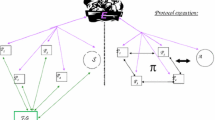Abstract
Proxy re-signature (PRS) allows a semi-trusted proxy served as a translator to transform a signature of delegatee into a signature of delegator on the same message. The heavy overhead of certificate management and the key escrow problem hinder the development of the public key infrastructure-based PRS scheme and the identity (ID)-based PRS, respectively. Featured with the certificate-free and escrow-free properties, certificateless PRS (CL-PRS) has attracted great attention from researchers. However, none of the existing CL-PRS satisfies the multi-use and unidirectional properties. Motivated by the practical applications with long signing chains and the untrusted relationship between two parties, it is desirable to construct a CL-PRS scheme with multi-use and unidirectional properties. This paper proposes the first multi-use unidirectional CL-PRS scheme based on the bilinear pairing. The presented scheme is proved to be secure based on the extended computational Diffie–Hellman assumption under the random oracle model. Performance evaluations demonstrate that our scheme is superior to related works.






Similar content being viewed by others
References
Blaze, M., Bleumer, G., & Strauss, M. (1998). Divertible protocols and atomic proxy cryptography. In Proceeding of international conference on the theory and application of cryptographic techniques, EUROCRYPT (pp. 127–144).
Ateniese, G., & Hohenberger, S. (2005). Proxy re-signatures: New definitions, algorithms, and applications. In Proceedings of the 12th ACM conference on computer and communications security (pp. 310–319).
Shao, J., Cao, Z., Wang, L., & Liang, X. (2007). Proxy re-signature schemes without random oracles. In Proceedings of the 8th international conference on cryptology in India, INDOCRYPT (pp. 197–209).
Libert, B., & Vergnaud, D. (2008). Multi-use unidirectional proxy re-signatures. In Proceedings of the 2008 ACM conference on computer and communications security (pp. 511–520).
Guo, D., Ping, W., Dan, Y., & Xiaoyuan, Y. (2010). A certificateless proxy re-signature scheme. In Proceedings of the 3rd international conference on computer science and information technology (Vol. 8, pp. 157–161). IEEE.
Xiao, H., & Zhang, M. (2013). Provably-secure certificateless proxy re-signature scheme. In Proceedings to international conference on intelligent networking and collaborative systems (pp. 591–594).
Chen, L., Chen, X., Sun, Y., & Du, X. (2014). A new certificateless proxy re-signature scheme in the standard model. In Proceedings to the 7th international symposium on computational intelligence and design (Vol. 1, pp. 202–206). IEEE.
Chen, Y., Xu, W., Peng, L., & Zhang, H. (2019). Light-weight and privacy-preserving authentication protocol for mobile payments in the context of IoT. IEEE Access, 7, 15210–15221.
Jiang, Q., Qian, Y., Ma, J., Ma, X., Cheng, Q., & Wei, F. (2019). User centric three-factor authentication protocol for cloud-assisted wearable devices. International Journal of Communication Systems, 32(6), e3900.
Liu, Y., & Zhao, Q. (2019). E-voting scheme using secret sharing and K-anonymity. World Wide Web, 22(4), 1657–1667.
Jiang, Q., Ma, J., Yang, C., Ma, X., Shen, J., & Chaudhry, S. A. (2017). Efficient end-to-end authentication protocol for wearable health monitoring systems. Computers & Electrical Engineering, 63, 182–195.
Jiang, Q., Huang, X., Zhang, N., Zhang, K., Ma, X., & Ma, J. (2019). Shake to communicate: Secure handshake acceleration-based pairing mechanism for wrist worn devices. IEEE Internet of Things Journal, 6(3), 5618–5630.
Shao, J., Wei, G., Ling, Y., & Xie, M. (2011). Unidirectional identity-based proxy re-signature. In Proceedings of IEEE international conference on communications, ICC (pp. 1–5).
Yang, T., Xiong, H., Hu, J., Wang, Y., Xin, W., Deng, Y., & Chen, Z. (2011). A traceable privacy-preserving authentication protocol for VANETs based on proxy re-signature. In Proceedings of the 8th international conference on fuzzy systems and knowledge discovery (pp. 2217–2221).
Tian, M. (2015). Identity-based proxy re-signatures from lattices. Information Processing Letters, 115(4), 462–467.
Wang, Z., & Xia, A. (2015). ID-based proxy re-signature with aggregate property. Journal of Information Science and Engineering, 31(4), 1199–1211.
Yang, X., Xiao, L., Li, Y., Li, S., Wang, J., & Chen, C. (2018). Identity-based blind proxy re-signature scheme for data security. In Proceedings of the 3rd IEEE international conference on data science in cyberspace (pp. 28–32).
Lee, E., & Kim, S. W. (2018). Non-interactive conditional proxy re-signature in the standard model. The Computer Journal, 61(12), 1772–1782.
Huang, X., Mu, Y., Susilo, W., Wong, D.S., & Wu, W. (2007) Certificateless signature revisited. In Proceedings of 12th Australasian conference on information security and privacy, ACISP (pp. 308–322).
Xiong, H., & Qin, Z. (2015). Revocable and scalable certificateless remote authentication protocol with anonymity for wireless body area networks. IEEE Transactions on Information Forensics and Security, 10(7), 1442–1455.
Xiong, H., Mei, Q., & Zhao, Y. (2019). Efficient and provably secure certificateless parallel key-insulated signature without pairing for IIoT environments. IEEE Systems Journal,. https://doi.org/10.1109/JSYST.2018.2890126.
Liu, Y., Wang, Y., Wang, X., Xia, Z., & Xu, J. (2019). Privacy-preserving raw data collection without a trusted authority for IoT. Computer Networks, 148, 340–348.
Xiong, H., Mei, Q., Zhao, Y., Peng, L., & Zhang, H. (2019). Scalable and forward secure network attestation with privacy-preserving in cloud-assisted internet of things. IEEE Sensors Journal,. https://doi.org/10.1109/JSEN.2019.2919508.
Xiong, H. (2014). Cost-effective scalable and anonymous certificateless remote authentication protocol. IEEE Transactions on Information Forensics and Security, 9(12), 2327–2339.
Acknowledgements
This research is supported in part by the 13th Five-Year Plan of National Cryptography Development Fund for Cryptographic Theory of China under Grant MMJJ20170204 and in part by Sichuan Science and Technology Project under Grant 2018KZ007.
Author information
Authors and Affiliations
Corresponding author
Additional information
Publisher's Note
Springer Nature remains neutral with regard to jurisdictional claims in published maps and institutional affiliations.
Rights and permissions
About this article
Cite this article
Wu, Y., Xiong, H. & Jin, C. A multi-use unidirectional certificateless proxy re-signature scheme. Telecommun Syst 73, 455–467 (2020). https://doi.org/10.1007/s11235-019-00623-2
Published:
Issue Date:
DOI: https://doi.org/10.1007/s11235-019-00623-2




